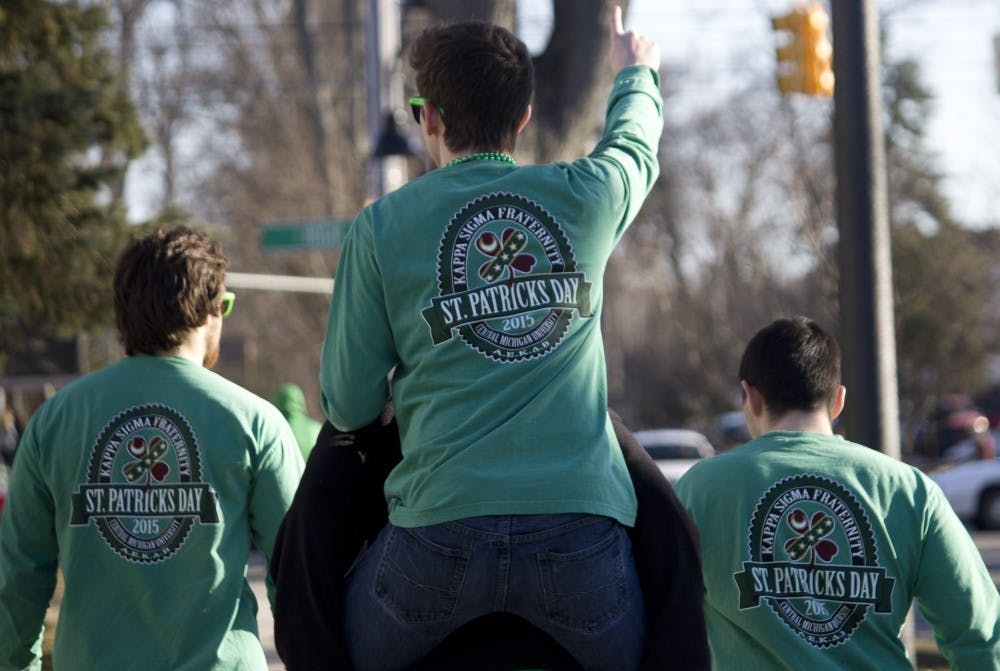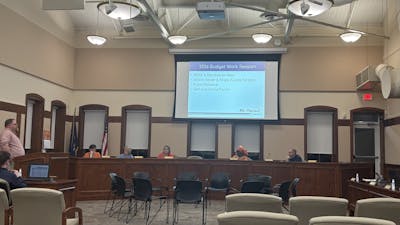'Everything green, everything beer': History, traditions of St. Patrick's Day

This Friday, March 17, the streets and bars of Mount Pleasant will be filled with green colors, people wearing symbols of clover and gold for the legendary leprechauns. St. Patrick’s Day, a religious Irish holiday, is an American favorite time to party according to Carrie Euler, a faculty member at the department of History, World Languages and Cultures.
Traditionally St. Patrick's Day in America is celebrated with Irish music, food and parades according to the History website.
History of St. Patrick’s Day
The story of St. Patrick’s Day starts in 5th century in Ireland, Euler said. According to the National Geographic, St. Patrick's real name was Maewyn Succat. St. Patrick’s legend tells us that he was kidnapped early in life from England by Irish people and taken to Ireland.
During the 5th century Ireland was “tribal”, she said. It was populated with Celtic people. England at that time had Romans leaving its territory and Anglo-Saxons coming in — it was “pretty choatic”, Euler said.
Eventually St. Patrick escaped Ireland and ended up in France, where he converted to and studied Christianity, Euler said. St. Patrick decided it was his calling to go back to Ireland and spread Christianity to the Irish.
Euler said it is most likely that St. Patrick died around 460 CE.
The Irish started viewing St. Patrick as an official patron of Ireland around the 20th century, Euler said. The church declared him as a saint early on because of his commitment to Christianity.
“Saints were basically people who lived very holy lives, and were very dedicated and pious to Christianity,” Euler said. “After they (saints) die, people believe that they witness miracles that were performed by the saints.”
For example, she said, one of such miracles of St. Patrick is described in the legend about snakes. Now it is believed that Ireland doesn’t have any snakes because St. Patrick has drove all of them out of the country.
Euler said all the saints named by the Catholic Church have “saint days”. For example, she said, another well-known saint day is St. Valentine’s Day on Feb. 14. St. Valentine’s was a real person who was named a saint for his devotion to Christianity.
However, she said, historians don’t know for sure if St. Patrick was a real person.
“There isn’t a lot of evidence that has survived,” Euler said. “There’s no document that says ‘I just talked to this guy named Patrick.’ We don’t have first hand accounts.”
How did the holiday come to the U.S.?
Euler said St. Patrick’s Day in Ireland is more of a religious holiday. She said people go to mass, which might be held in Celtic language that day instead of English. Irish also decorate their dresses with shamrocks, a rare plant similar to clover that grows in Ireland.
“I gather that the huge parties and everything green and everything beer and green beer is an American thing,” Euler said.
Irish immigrants traveling to America in the early 20th century brought the St. Patrick’s Day to the United States she said. The Irish immigration to America mainly took place between 1850s and 1920s when a big potato famine happened in Ireland.
“There's this kind of stereotype of the Irish are so fun and friendly and they party,” Euler said.
She said the Ancient Order of Hibernians in the New York City wanted to show that there are prosperous Irish people to fight the prejudice against them. They held a parade on St. Patrick’s Day.
Later, Boston and Chicago started celebrating the holiday as well, Euler said.
Now, she said “major cities in Ireland … do have parades, but that is mainly because of all the American tourists that want them.”
Traditions of celebrating
Euler said traditional attributes of the St. Patrick’s Day are leprechauns, mischievous mythological creatures, shamrocks, Guiness, traditional Irish beer and the color green, which symbolizes the hills of Ireland.
Andrea Devenney is a faculty member in the department of English. She lived in Ireland from 2004 to 2005 while her husband, Andrew Devenney, an associate director of the Center for Learning Through Games and Simulations at Central Michigan University, studied for his doctoral degree in an international fellowship called Fulbright Fellow.
“(Irish) were friendly and accommodating people,” Devenney said. “I liked all the buildings, and the things are just unique looking.”
Devenney said now at home for St. Patrick’s Day she cooks traditional Irish food such as corned beef, mashed potatoes with Irish cheddar, soda bread, cabbage and carrots.
“Celebrating St. Patrick’s Day reminds me a little bit of some of the time that I spent there and gives me some opportunity to reflect on a little bit of fond memories that I have,” Devenney said.
Devenney said she would want to show CMU students Ireland as well. She said she tried to set up a study abroad trip to Ireland in 2018 and 2019, but it never got enough students.
Sophia Person and Taryn Marino are teaching Irish dancing at the Motor City Irish Dance. They said Irish dancing is a popular tradition for the St. Patrick’s Day. Person and Marino will be dancing for several different festivals and restaurants in Detroit this year for the holiday.
“I think especially in American St. Patrick’s Day … is about celebrating Irish culture,” Person said. “Irish dancing is expected and for a lot of people (during St. Patrick’s day) is the only (time) that you’ll see it, which is cool.”
Irish dancing is unique because a performer dances only with their feet, Person said. For dancing, special types of shoes such as soft and hard ones could be used, she said.
“I think the art itself is really cool,” Marino said. “Dancing itself helps you focus on what you’re doing … Performing it gives me a sense of community.”
Kourtney John is an office assistant at Clare Area Chamber of Commerce. Clare, a city in Michigan well-known for its Irish heritage, will hold its 48 annual celebration of St. Patrick's Day. John said traditional celebrating of St. Patrick's Day in Clare has several Irish special events throughout the week of March, 17.
"I think it's really enjoyable," John said. "We get a lot of people it's busy. Everyone's always having fun. We usually have Irish music playing and that's cool."
She said businesses in Clare will have traditional Irish food and beer. Clare Chamber holds a raffle, a silent auction, a run and a parade. To learn more about the Irish traditions in Clare, visit the Chamber's website.
At CMU a matcha tasting and celebration of St. Patrick’s Day will take place March 17 in Ronan 345, according to the flyer from International Student Information.
To find more events celebrating St. Patrick’s Day visit Engage Central.
To celebrate St. Patrick's Day in Mount Pleasant, go to the Meet Mount Pleasant website.






